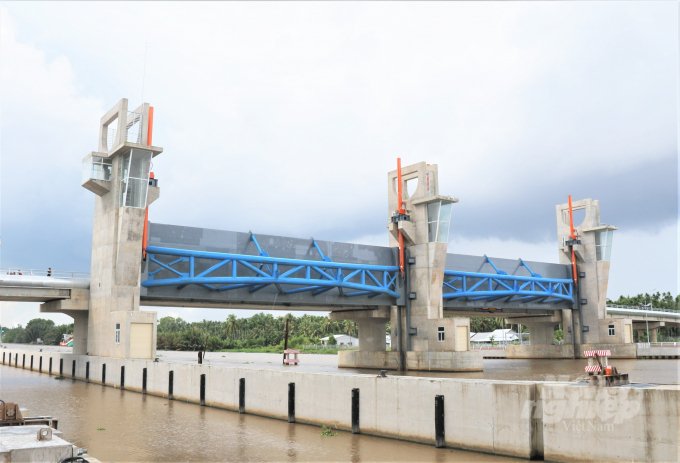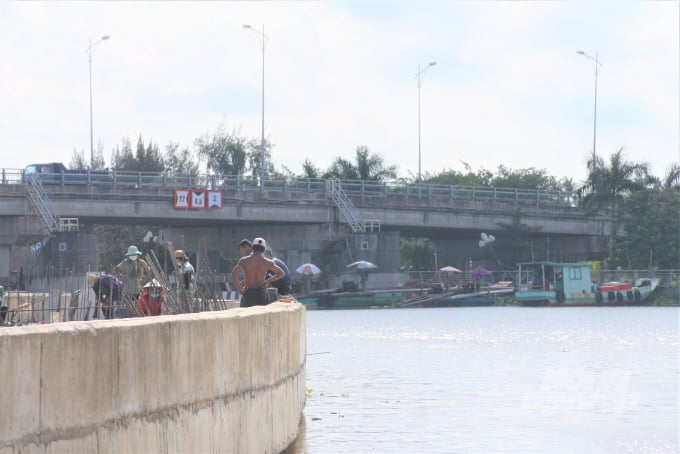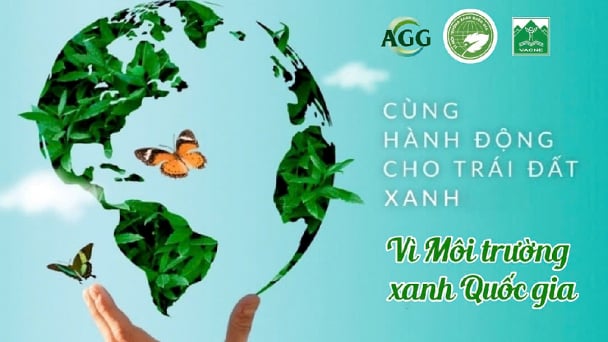May 18, 2025 | 10:47 GMT +7
May 18, 2025 | 10:47 GMT +7
Hotline: 0913.378.918
May 18, 2025 | 10:47 GMT +7
Hotline: 0913.378.918

The work of regulating saltiness and sweetness of Cai Be sewer in Kien Giang province. Photo: Pham Hieu.
The Mekong Delta is one of the regions with the most significant groundwater potential in Vietnam, with seven principal aquifers. The distribution depth ranges from tens of meters to 500-600 meters. Areas with great potential for freshwater resources include Bac Lieu, Long An, Dong Thap, Ca Mau, Tra Vinh, and Can Tho provinces.
The freshwater potential exploitation reserve is about 22.5 million m3 per day. The potential reserve of brackish and saline water is about 39 million m3 per day. The safe exploitation of fresh water in the whole region is about 4.5 million m3 per day.
In the dry season of 2019-2020 alone, over 160 concentrated water supply works in the Mekong Delta were affected by saltwater intrusion, causing about 430,000 people in the region to have difficulty accessing water for daily life.
However, in recent years, the Mekong Delta has been facing the harsh impacts of climate change. The phenomenon of sea-level rise, heat waves, heavy rain on a large scale, strong thunderstorms accompanied by tornadoes, lightning, scarcity of freshwater... occur irregularly and widely in the region.
Along with that is the phenomenon of high tide causing flooding, riverbank erosion... The weather is currently happening irregularly, erratic, and almost unpredictable according to the traditional experience. The sun is more prolonged and more intense, the rain is heavier, the rain is more serious, the saltwater is also getting deeper and deeper, the storms and floods appear more and last longer.
In the 2019-2020 dry season alone, over 160 concentrated water supply works in the Mekong Delta were affected by saltwater intrusion, causing about 430,000 people to have difficulty accessing water for daily life.
The Mekong Delta has favorable natural conditions for aquaculture development. Therefore, the Mekong Delta has great potential for aquaculture development with its natural advantages.

Operation of Cai Be sewer. Photo: Pham Hieu.
According to the Ministry of Natural Resources and Environment report, in the 2021 dry season, the Mekong Delta will be able to investigate proactively, survey, explore, search for and organize the rational exploitation of water sources to supply water for people's daily life and production in the dry season, during saltwater intrusion; deploying 35 underground water exploitation works with a total flow of 33,000m3 per day, supplying over 333,000 people to use; hand over the groundwater map to all the localities in the Mekong Delta with dozens of drilled wells for localities to invest in and build into concentrated water supply works; making ten emergency water supply points with a total capacity of 3,700m3 per day and night, supplying 62,000 people in 7 provinces to fight against drought and salinity in the Mekong Delta region to use.
However, every time in the dry season, many localities still have a severe shortage of domestic water. Specifically, more than 16,600 households in Giong Trom district, Ben Tre province using domestic tap water from Luong Quoi Water Plant have to pay for the water of VND 51,500 VND per m3, five times higher than usual.
According to the factory's leader, previously, the water price was only VND 9,600 per m3, but the water source of the plant was contaminated with salt; Ben Tre Water Supply and Sewerage Joint Stock Company had to hire more than ten barges (average load 700 tonnes) transport freshwater from upstream to pump to serve people.
The coastal communes of 2 districts, An Bien, An Minh, Kien Giang province, have not had water supply works, wells are saline, water stored in ditches, dikes, puddles, after a few months of rain is inert, so people have to change water from homemade tank trucks with prices from VND 60,000 to VND 100,000 per m3.
People in island communes of Kien Hai, Kien Luong, and Ha Tien districts have even more severe water shortages. An Son commune, Kien Hai district has a reservoir of 30,000 m3, but the prolonged sunshine is in a state of exhaustion. In other communes of Kien Hai district, such as Hon Tre, Lai Son, Son Hai, Hon Nghe, Tien Hai, especially Nam Du island, the people's need for freshwater is extremely urgent.

In 2021, localities in the Mekong Delta have actively responded to saltwater intrusion by implementing the motto "save freshwater, regulate saltwater". Photo: Pham Hieu.
The Department of Agriculture and Rural Development of Bac Lieu province has implemented strong regulation of saline water into the converted sub-region to serve shrimp farming. The locality will operate Ninh Quoi sluice to prevent saltwater intrusion through Soc Trang province in parallel with water regulation.
The People's Committee of Tien Giang province has built eight steel dams to protect two freshening areas, Bao Dinh and Go Cong, and drilled 16 wells to find temporary water sources for people in remote areas. In addition, local authorities constantly recommend and guide farmers on solutions to reduce damage to crops if attacked by saltwater.
In addition to the temporary steel dam to prevent saline intrusion, the People's Committee of Tien Giang province also built seven other salt-preventing dams on canals and canals through district 35, including Ong Ho, Sao Bridge, Me, My Long, Chin Tuong, and Ba canals. Tra and Ong Muoi belong to Chau Thanh and Cai Lay districts.
In Ben Tre, the province has merged three temporary dams by Larsen piles on Ba Lai river's three main tributaries flowing through Thanh Trieu, Tuong Da, and An Hiep communes of Chau Thanh district to enter Cai Co area - Main raw water station of Ben Tre Water Factory.
Currently, saline water in the main rivers of Ham Luong, Co Chien, and Ba Lai has increased, but the locality still owns the raw water source for the most critical water plant in the region.
According to the National Center for Hydro-Meteorological Forecasting, saltwater intrusion in rivers in the Southern region increases gradually. Ca Mau is the most affected locality, except for the central-western area, which is protected by a system of sluices to prevent salinity.
The flow of the Mekong River has greatly affected the decrease of salinity in the coastal areas of Tien Giang, Ben Tre, Tra Vinh, and Kien Giang. The salinity concentration in these areas decreased in June every year, while the salinity concentration in Soc Trang, Bac Lieu, and Ca Mau remained the same as in April.
In the future, Ca Mau will suffer the most significant economic loss due to saline intrusion, followed by Ben Tre, Bac Lieu, Soc Trang, and Tra Vinh. Ben Tre is the most affected province in terms of fruit production, followed by Soc Trang, Ca Mau, Kien Giang, and Tra Vinh.
Translated by Ha Phuc

(VAN) 14 out of 35 domesticated elephants in Dak Lak province have had their living conditions improved, with 11 of them currently participating in the non-riding elephant tourism model.

(VAN) Muong Nhe Nature Reserve hopes that being upgraded to a national park will lay the foundation for forest protection efforts to be carried out in a systematic, modern, and sustainable manner.
/2025/05/16/3923-2-171845_52.jpg)
(VAN) Lower costs, higher yields, and improved soil quality are outstanding benefits that soybeans bring when integrated into the crop rotation system.

(VAN) The 'For a Green National Environment' programme aims to promote a green lifestyle, support businesses in implementing ESG practices, and turn Net Zero commitments into concrete actions.

(VAN) Cold-barn systems efficiently manage environmental and temperature conditions, which aids in the prevention of respiratory diseases in pigs and protects them from the vectors that transmit African swine fevers.

(VAN) To tackle challenges, the project 'Addressing key technical bottlenecks in the grouper supply chain in Vietnam' has been underway since 2024.

(VAN) The project 'Disease-Resilient and Sustainable Cassava Production Systems in the Mekong Region', funded by the Australian Center for International Agricultural Research (ACIAR), is being implemented from 2024 to 2028.